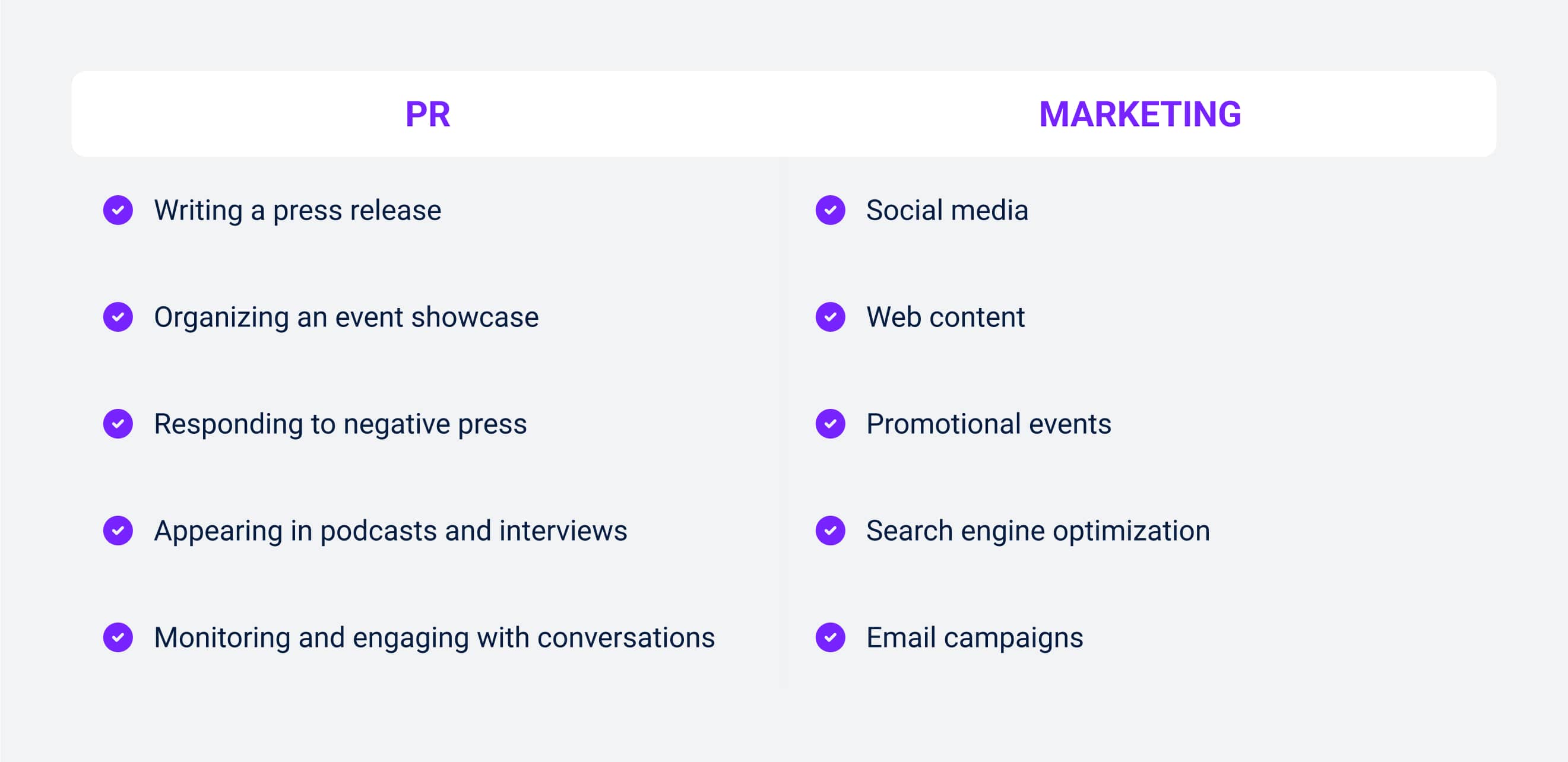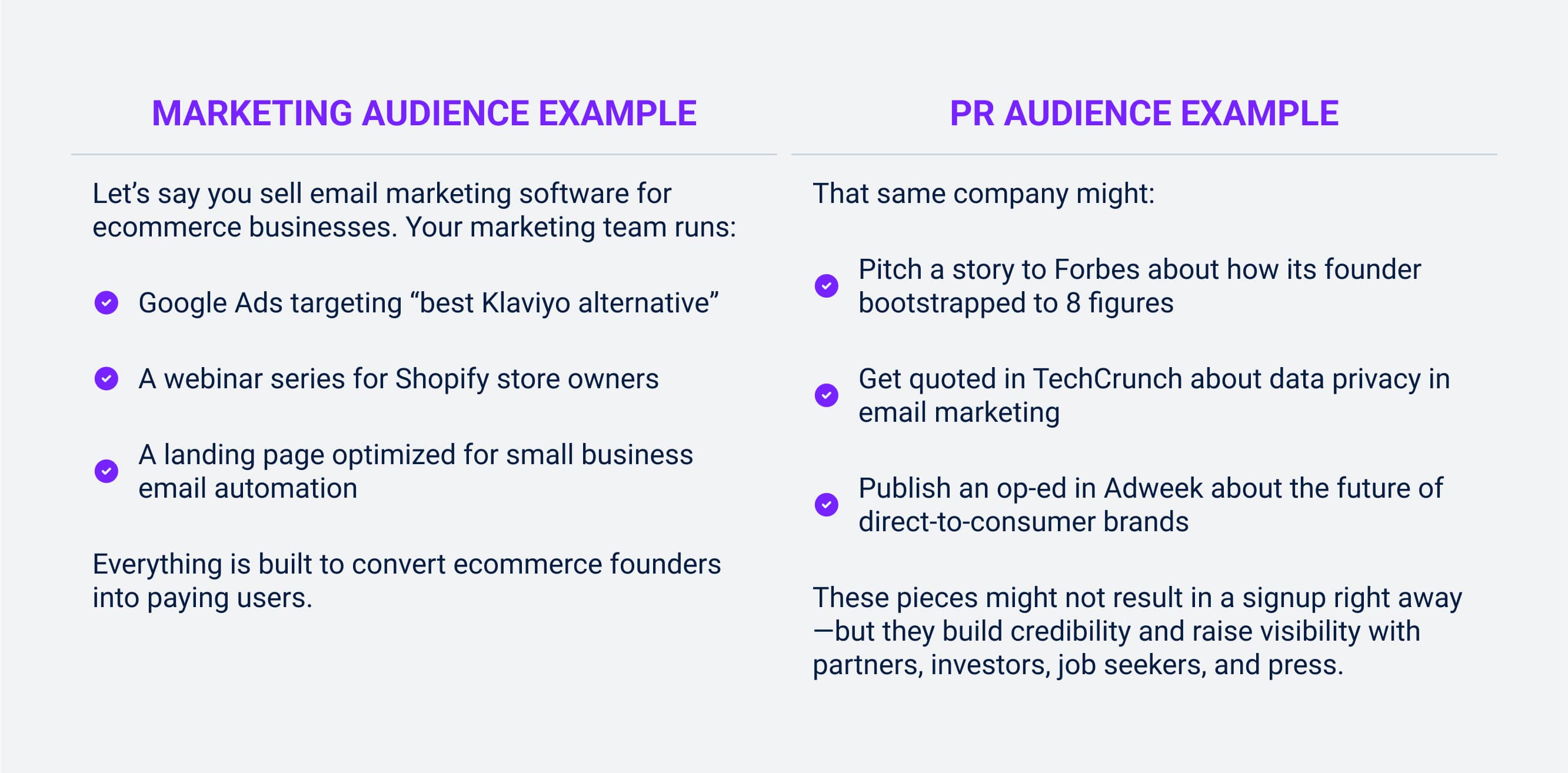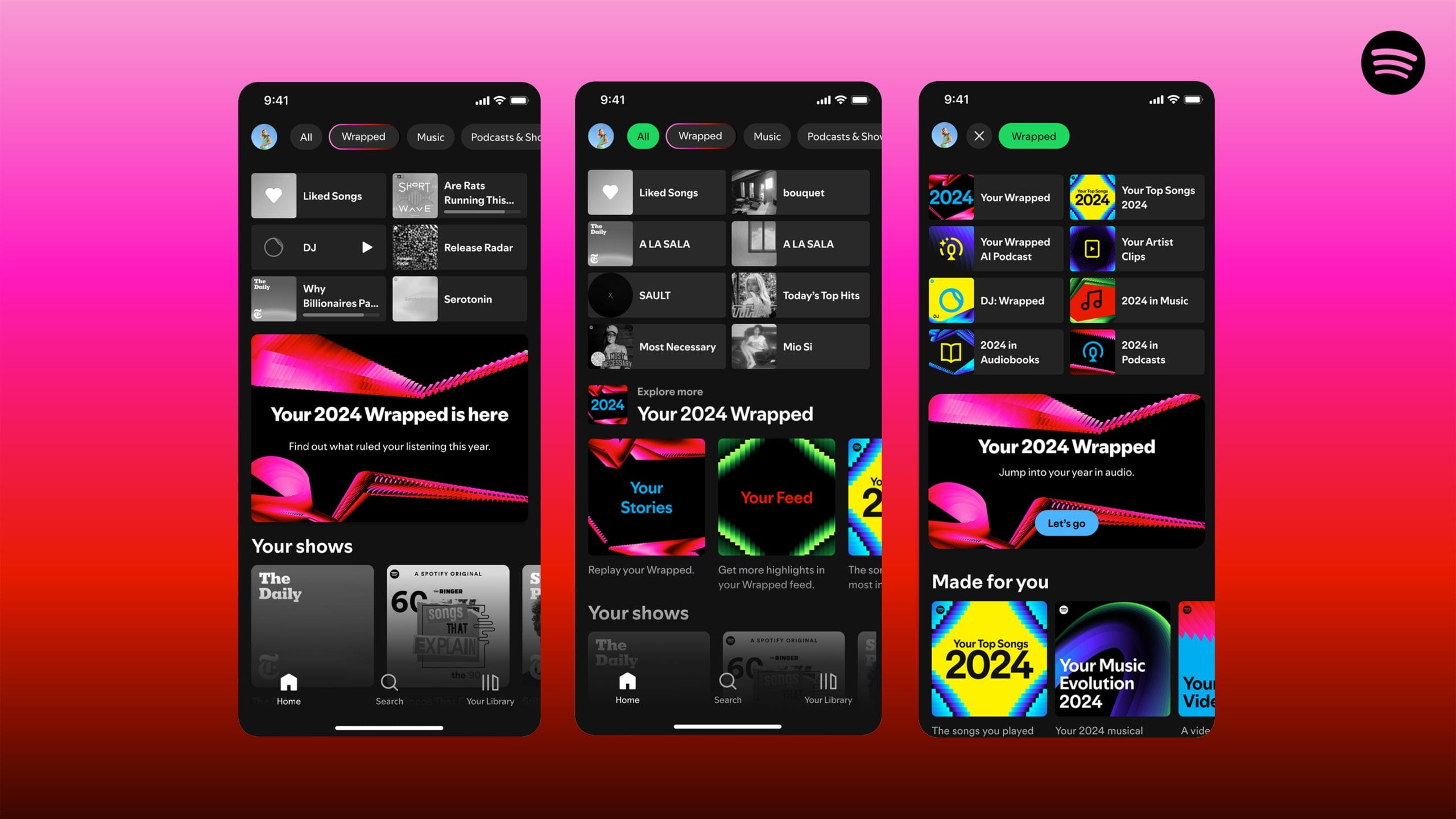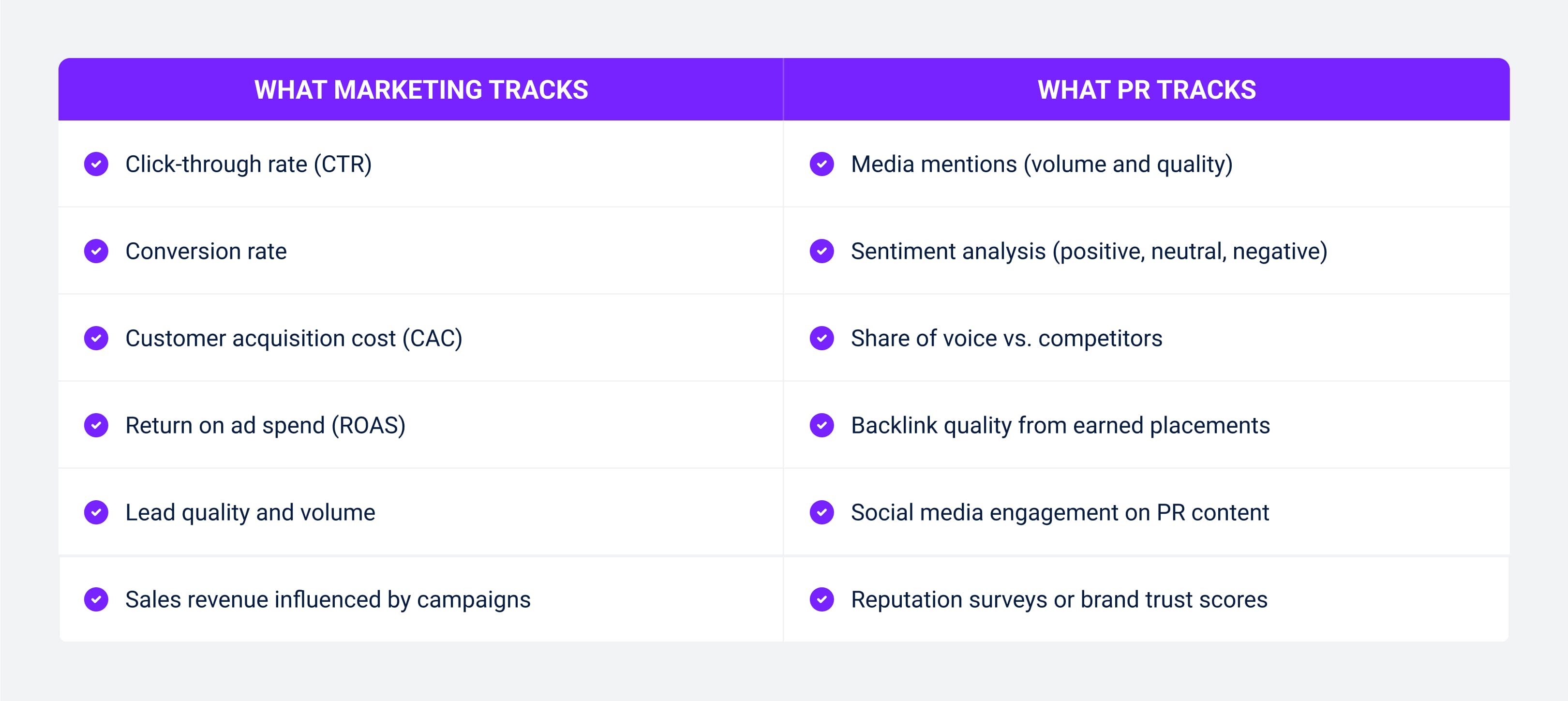If you want people to buy more of your stuff, there are countless ways to do it:
- Send press releases to publications and generate buzz around your product
- Create content to appear on websites or blogs
- Run search engine optimization campaigns and AdWords
- Organize special events that highlight your product or service
The list goes on. But two of the most prominent promotional techniques are marketing and public relations (PR).
Though they’re often confused—and sometimes used interchangeably—they’re actually quite distinct, serving different roles in any business or organization.
To understand why that is, let's take a closer look at public relations and marketing.
Marketing and PR work toward the same big goal: growing your brand. But they take very different paths to get there.
Marketing is about promoting something to drive sales. It’s what you use when you want someone to take action now: buy, sign up, book a call, click the link.
PR services focus on shaping perception through earned media coverage. It’s not just about attention. The importance of PR lies in its ability to change how the world sees you or your brand in the long run.
Here’s a simple way to think about it:
Marketing says, “Look at me.” PR gets others to say, “Look at them.”
You can run a marketing campaign without a PR strategy. You can do PR without spending a dime on ads. But the most powerful brands use both together—intentionally and strategically.
What is the difference between PR and marketing?
PR and marketing are two distinct, yet intertwined strategies for promoting businesses. Though both are essential for any successful business or organization, their approaches and objectives differ in important ways.
Here are seven key differences between PR and marketing:
Approach
Marketing and PR take fundamentally different approaches.
- Marketing takes a direct approach. It’s about actively pushing a message, offer, or product to your audience. You control the channel, the format, and the timing.
- PR takes an indirect approach. It’s about building goodwill and earning coverage. You’re trying to influence how the media, influencers, analysts, and the general public think about you.

Let’s look at some examples:
PR in action
- You write a press release announcing your company’s expansion into a new market.
- You secure a guest appearance on a high-profile industry podcast.
- You get a story written about your founder in Fast Company.
These are examples of earned media. You’re not paying to promote, but rather earning attention through newsworthiness, relationships, or brand value.
The perfect example? Bumble’s IPO Media Blitz.
When Bumble went public, they didn’t just market the stock, they told a story. Founder Whitney Wolfe Herd did interviews with The New York Times, NPR, and Time, focusing on her role as one of the few female tech CEOs and how Bumble was changing the dating landscape.
The result? Massive coverage that wasn’t about revenue or user counts, but about brand values, vision, and leadership.

Marketing in action
- You run Google Ads targeting people searching for “AI writing tools.”
- You launch a product via a paid webinar funnel with email retargeting.
- You optimize your website content for SEO and create lead magnets to capture email addresses.
These are owned or paid media channels you control or pay to access.
An example of this? Apple’s “Shot on iPhone” campaign.
They combined billboard ads, social media, and in-store displays to showcase user-generated content, highlighting the product’s capabilities through visual storytelling.
It was marketing, but it had a PR effect: It made people trust the quality without needing a word of copy (well, besides the three in the campaign).
Tactics
The tactics used in PR and marketing also differ in many ways.
PR campaigns typically involve creating or disseminating content that tells stories about the brand and its products, building relationships with key influencers, responding to press inquiries, and providing crisis management services.
In some cases, PR stunts can be over the top for shock value, but they can also be subtle and strategic.
When Elon Musk sent a Tesla Roadster into space to test the new SpaceX Falcon Heavy rocket, for example, he didn't spend $90 million for no reason—his rocket test served as a PR stunt to increase public interest in SpaceX while teasing the new Tesla Roadster.
Marketing campaigns are usually more abstract, and the creative nuance is meant to capture the attention of potential customers. There are simple tactics (e.g., paid social, email, search ads), but marketing also requires developing innovative strategies to reach new customers.
GoPuff's app gives customers a unique and convenient way to purchase convenience store items. As you may have noticed, GoPuff proudly shares its wacky commercials and quirky ads.
But one of the most unique ways it promotes its products is by highlighting the unusual shopping list items people order, along with the time that they order them.

In Mexico City, Uber launched a guerrilla marketing campaign for UberPOOL in which it flew drones with signs that promoted the rideshare service to cars that were stopped in rush hour traffic.
There is no real scientific way to explain why some marketing campaigns work. Marketing just takes clever and innovative creativity.
Target audience
One of the biggest differences between PR and marketing is who you're trying to reach.
Marketing speaks directly to your ideal customer — the person who's most likely to buy what you’re selling. Every campaign is designed with that buyer in mind: their pain points, desires, behavior, and decision-making process.
PR is a lot broader. You’re targeting anyone who can influence how your brand is perceived. That could be media, investors, employees, the public, even regulators. The cost of PR is worth it because you’re playing the long game, and your audience may not become customers at all.
Bottom line: Marketing is for buyers. PR is for everyone watching.

Goals
At a glance, PR and marketing might look like they’re working toward the same outcome (growth). But their goals are actually quite different.
- Marketing is outcome-driven. The goal is clear and measurable: more sales, more leads, more conversions. You launch campaigns with click-through rate, cost per acquisition, and ROI in mind.
- PR is perception-driven. The goal is influence: shaping how people think and talk about your brand. It’s harder to quantify, but just as powerful, especially when trust is on the line.

Marketing goals in action
Spotify Wrapped is a brilliant example. Each December, Spotify gives users a personalized year-in-review they can share online. While it feels like a fun, organic moment, it’s really a strategic marketing play.

The goals?
- Boost user engagement
- Increase brand stickiness
- Drive organic social sharing to attract new users
It works. Every year, Spotify Wrapped dominates social feeds, earns free exposure, and drives a spike in downloads.
PR goals in action
Airbnb’s “We Accept” Campaign (launched during the Super Bowl) wasn’t selling rentals, it was responding to criticism about discrimination on the platform. While it was an ad, it served a PR purpose: crisis response.
The goal?
- Rebuild public trust
- Reinforce company values
- Shift the media narrative
They paired their ad with policy changes, partnerships, and media outreach to completely reshape public perception from the ground up.
Metrics you track
Marketing metrics are concrete. You’re tracking how your efforts impact the bottom line. Did someone click? Buy? Sign up? Share?
PR metrics are qualitative. You’re asking: Did we earn attention? Did we shape the conversation? Are we seen as credible?
Let's say you work with us on a Meta ad campaign for your course platform. Your key KPIs:
- Cost per lead under $6
- 3% landing page conversion rate
- 10% lift in sales during the promo period
After we run the ads for a few hours, we'll see the results and can optimize from there. We'll also A/B test multiple ads to see which one converts the best (something you can't really do with PR).
PR's trickier to measure because it's not conversion-oriented. It's not "right on the money" as they say.
Suppose you're working with us on a campaign about your company’s climate initiatives You:
- Track 50+ earned media placements
- Analyze that 80% had positive sentiment
- Notice a spike in branded search volume and LinkedIn followers
That marks a positive perception shift, which'll help you in the long run, but won't show up on your hard-number reports.

Toolkit and tech stack
PR and marketing efforts require different tools to be successful.
For PR, your tech stack will include the following:
- Media databases: Platforms like Cision and Muck Rack provide comprehensive media directories and contact databases that you can use to find and reach out to journalists, bloggers, and other influencers.
- Public relations platforms: Platforms like PR Newswire provide the tools needed for press release distribution services, tracking coverage, managing contacts, creating story pitches, and more.
- Social monitoring software: Tools like Mention and Brand24 are perfect for tracking online mentions, comments, and reviews of your brand.
- Content creation tools: Tools like Adobe Spark, Canva, and Hootsuite Amplify provide all the tools needed to create top-notch visuals for your stories.
- Reporting and analytics: Platforms like Meltwater Insights and Pitchbox provide detailed reporting features which allow you to measure the success of your campaigns.
WE ARE A FULL-SERVICE PR AGENCY
Get featured in top-tier media, build credibility fast, and attract new business with proven PR strategies that actually deliver results.
Let's talk - Schedule a call with our expert team today to see how we can help!
Meanwhile, marketers will tools for completely different workflows:
- Marketing automation: Platforms like HubSpot, Marketo, and ConvertKit provide the infrastructure and analytics needed to measure customer behaviors and automate personalized campaigns.
- Ad platforms: If you're running ads, you'll be using Google Ads, Meta Ads, LinkedIn Ads, or whichever tool corresponds to where you're running ads.
- SEO tools: Software like Ahrefs or Semrush for keyword/competitor research and SurferSEO for content optimization are absolute MUSTs if you're running SEO campaigns.
- Email marketing: If email is part of your multichannel campaign, you'll need something like Mailchimp, Klaviyo, or ActiveCampaign to automate it.
- Marketing analytics: Platforms like Google Analytics and Mixpanel provide insights into customer behavior, allowing you to track conversions and optimize your campaigns for maximum ROI.
- Social media management: Platforms like Hootsuite and Sprout Social are perfect for managing social media profiles across multiple platforms.
- Content management system (CMS): A CMS like WordPress or Squarespace is necessary for creating and managing a website.
Time frame
PR and marketing efforts require different time frames to be successful. PR teams often have to work weeks, months, or even years ahead of a major launch or product announcement to ensure that the right people hear their message.
On the other hand, marketers can often get results much faster if they run paid ads or other performance-based campaigns. Depending on the specific campaign, you might see results within hours or days with marketing.
Take Aldi’s “Swap and Save” campaign in the UK. Aldi ran aggressive price comparison ads showing how customers could save by switching from major supermarkets. They backed it with TV spots, digital ads, and in-store promotions.
Now contrast that with LEGO’s sustainability initiative. In 2018, LEGO announced it would begin making some bricks from plant-based plastics and committed to sustainability as a brand value.

Nobody will be on board right away, but they will start to pay closer attention. That attention will turn into extra revenue from eco-conscious customers later on.
Some forms of marketing (SEO, content marketing) take longer to drive results, but they produce a more sustained level of growth over time. And like marketing, PR is needed if you're building immediate awareness (e.g., when recovering from bad publicity).
Still, overall:
- PR = Long-term, sustainable brand awareness
- Marketing = Short-term bursts of attention and results
Do marketing and PR work together?
The short answer: Yes.
Although they're two drastically different industries, marketing and PR have always gone hand in hand, like two peas in a pod.
While marketing focuses on the tactics used to promote an organization's products or services, public relations works to build relationships with customers, stakeholders, media outlets, and communities.
Combining the two gives you an advantage by better positioning your brand, with PR developing goodwill by raising awareness of the company's culture and achievements, while marketing provides a tangible vehicle for getting a message out to target audiences.
Example: Peloton used marketing to dominate Instagram and YouTube with sleek product ads and influencer partnerships. But they also invested heavily in PR by featuring their instructors in The New York Times, telling brand stories in Forbes, and leading conversations about fitness tech in mainstream media.
When you use the two together, your brand gets a serious edge.
Frequently Asked Questions
What comes first: marketing or PR?
Marketing is the logical first step for any business looking to efficiently deliver its services or products to those who are unaware of its existence. Promotion is crucial in getting the most out of your public relations tactics and reaping rewards from them.
However, some brands would benefit more from a PR-first approach. Suppose a company is relatively unknown or has something controversial to say. In that case, public relations can help set the stage for marketing activities by building trust and credibility before introducing a product or service.
How can you use PR and marketing together?
PR and marketing should be intertwined to achieve the greatest success. For example, if you're using email campaigns for your product launch, PR could focus on building anticipation by leveraging influencers or creating stories about the product.
At the same time, marketers can set up ads targeting those who have expressed an interest in similar products or services. Once the launch has happened, PR teams can focus on post-launch stories and interviews while marketers can use retargeting campaigns to reach people who have interacted with the product or brand.
Is PR under marketing?
PR and marketing are two different disciplines, with their own strategies and tactics. While PR teams often report to the marketing department, they are distinct entities that should be managed separately.
That said, there is a benefit to having them work together as one unified team. Working in tandem can ensure better results than either strategy can achieve alone.

